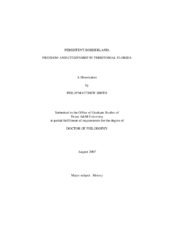| dc.description.abstract | Florida’s Spanish borderland was the result of over two hundred and fifty years of cooperation and contention among Indians, Spain, Britain, the United States and Africans who lived with them all. The borderland was shaped by the differing cultural definitions of color and how color affected laws about manumission, miscegenation, legitimacy, citizenship or degrees of rights for free people of color and to some extent for slaves themselves. The borderland did not vanish after the United States acquired Florida. It persisted in three ways. First, in advocacy for the former Spanish system by some white patriarchs who fathered mixed race families. Free blacks and people of color also had an interest in maintaining their property and liberties. Second, Indians in Florida and escaped slaves who allied with them well knew how whites treated non-whites, and they fiercely resisted white authority. Third, the United States reacted to both of these in the context of fear that further slave revolutions in the Caribbean, colluding with the Indian-African alliance in Florida, might destabilize slavery in the United States. In the new Florida Territory, Spanish era practices based on a less severe construction of race were soon quashed, but not without the articulate objections of a cadre of whites. Led by Zephaniah Kingsley, their arguments challenged the strict biracial system of the United States. This was a component of the persistent borderland, but their arguments were, in the end, also in the service of slavery and white patriarchy. The persistent border included this ongoing resistance to strict biracialism, but it was even more distinct because of the Indian-African resistance to the United States that was not in the service of slavery. To defend slavery and whiteness, the United States sent thousands of its military, millions of its treasure, and spent years to subdue the Indian-African alliance and to make Florida and its long shorelines a barrier to protect whiteness and patriarchy in the Deep South. | en |


